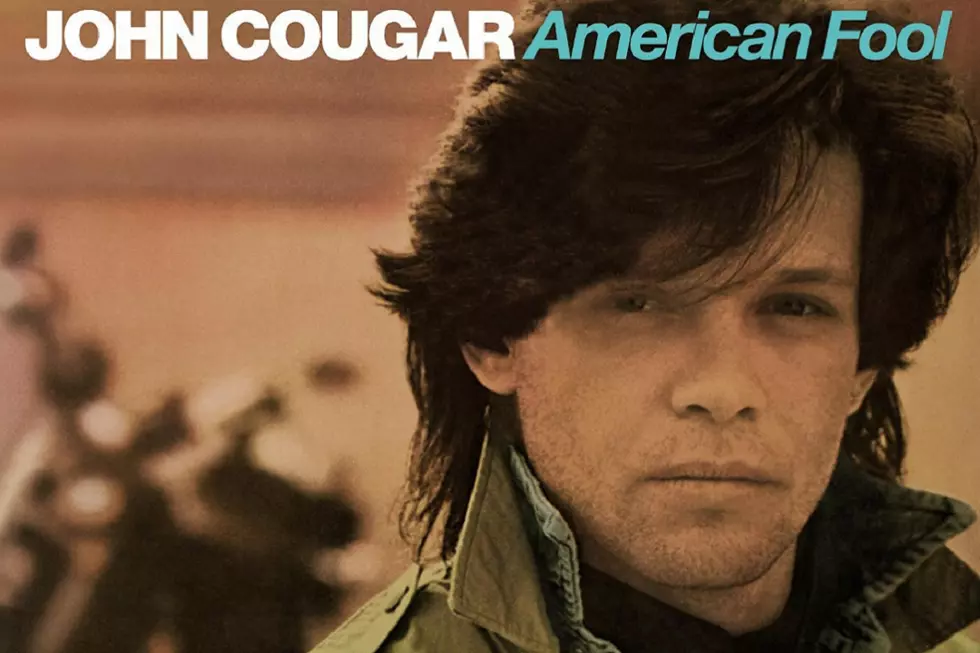
Revisiting John Mellencamp’s Only No. 1 Album, ‘American Fool’
By the time John Mellencamp had the No. 1 song and the No. 1 album in the country, it had been a long road to get there. But in 1982, no one by the name Mellencamp was to be found anywhere on the Billboard charts, MTV or pop radio. No, these successes belonged to John Cougar, a stage name that had been foisted upon the naive Indiana native when he was just starting out.
As rock ’n’ roller Johnny Cougar, and then simply John Cougar, Mellencamp had seen his dreams become reality, come crumbling down, then turn a new corner. In the first five years of his career, he entered into lousy management deals, watched his second LP go unreleased and then discovered a bit of popular success with Top 40 singles “I Need a Lover,” “This Time” and “Ain’t Even Done With the Night.” But success wasn’t enough. The burgeoning songwriter wanted to find his signature sound: less shiny, more rootsy, but still bold.
Mellencamp thought he might do just that with producer Don Gehman, who had worked as an engineer on one of his previous records. On one of the first days of recording for the new album in 1981, Mellencamp played Phil Collins’s recent hit, “In the Air Tonight,” for Gehman while they were working at Miami’s Criteria Studios.
“He said, ‘This is what I want to create’,” Gehman recalled to Sound on Sound. “‘I want to have a couple of verses that sound like a little folk song and then I want the big, bombastic entrance of some drums, and we’ll take it to a whole new place’.”
So “In the Air Tonight” became one of the inspirations for a new song Mellencamp had been working on called “Jack & Diane.” He spoke in interviews about creating songs out of “insignificant moments” in life or just things he had witnessed touring around America. The characters of “Jack & Diane” were an interracial couple, inspired by the mixed-race couples Mellencamp had met on tour.
“I thought it was cool,” Mellencamp told Rolling Stone in 2013. “The song was my effort to make a song about that, but of course the record-company guy didn’t like it. … I took his advice and made Jack a football star.”
The songwriter developed a clear vision for his characters over time, but the recording was a different story. Mellencamp claimed the strange arrangement, the “stopping and starting,” was because he had trouble communicating his musical ideas to the guys in the studio. The song took shape with the help of ex-David Bowie guitarist Mick Ronson, whom Mellencamp and Gehman had invited to the sessions.
“I owe Mick Ronson the hit song ‘Jack & Diane’,” Mellencamp admitted in 2008. “Mick was very instrumental in helping me arrange that song, as I’d thrown it on the junk heap. ... All of a sudden, for ‘Jack & Diane,’ Mick said, ‘Johnny, you should put baby rattles on there.’ I thought, ‘What the f--- does put baby rattles on the record mean?’ So he put the percussion on there and then he sang the part, ‘Let it rock, let it roll’ as a choir‑ish‑type thing, which had never occurred to me. And that is the part everybody remembers on the song. It was Ronson’s idea.”
Although Mellencamp and Gehman thought “Jack & Diane,” as well as a couple other new songs, sounded like the building blocks of a promising album, they were met resistance from the people at the singer’s record label, Riva. It seems that they had different ideas of what John Cougar should sound like.
“We had a record company that was hoping we were making a Neil Diamond‑type album, and after we spent two or three months in the studio recording these songs and mixing them to the best of our ability, I can remember an A&R guy in a pink shirt coming in to listen to them and basically thinking we had nothing,” Gehman remembered. “At that point, they put a stop to the project. We had ‘Jack & Diane,’ we had ‘Hand to Hold on To,’ we had ‘Weakest Moments’ – we had some good songs – and while I don’t know the precise nature of the discussions that took place, Riva went from wanting to get a new producer to not even wanting John on the label anymore. Finally, they came around to letting us finish it but wanting to hear the new songs we were going to cut.”
Listen to John Mellencamp's 'Hand to Hold on To'
Eventually, sessions commenced at Cherokee Studios in Los Angeles. In the time between, Mellencamp had worked up a new song with childhood friend George Green (who would also co-write “Crumblin’ Down” and “Rain on the Scarecrow,” among other Mellencamp hits) called “Hurts So Good.”
The singer was so pleased with how that song was realized that he began to feel more positive about the new album, titled American Fool, even if his label was still pessimistic. “The record company thought it would bomb,” Mellencamp said in 1984, “but I think the reason it took off was – not that the songs were better than my others – but people liked the sound of it, the ‘bam‑bam‑bam’ drums. It was a different sound.”
And take off it did. After being released on April 12, 1982, American Fool and its lead single “Hurts So Good” began climbing the charts. By the summer, it had spent 16 weeks in the Top 10 of the U.S. charts (more than any pop song in the ’80s) peaking at No. 2.
Listen to John Mellencamp's 'Hurts So Good'
Around the same time “Hurts So Good” was reaching its crest, “Jack & Diane” hit the airwaves – supported by a video that Mellencamp had shot on the sly, patching it together with old family photos. The low-fi video and strangely orchestrated tune ended up capturing the public’s imagination. In the fall of 1982, “Jack & Diane” spent a few weeks atop Billboard. American Fool stayed on top of the album chart for a couple months. The LP would end up going platinum five times.
Although Mellencamp wasn’t fully satisfied with his songwriting on American Fool, he was thrilled to reap the rewards of success. One of those was the ability to begin reclaiming his actual name. The next time he’d put out an album, it would be credited to John Cougar Mellencamp.
If Mellencamp isn't crazy about American Fool, listeners sure have been. It remains his only No. 1 album and his bestseller (followed closely by 1985’s Scarecrow). Meanwhile, “Jack & Diane” is probably the singer-songwriter’s most beloved song.
“I think people, particularly in the Midwest, really identified with these characters,” he said in 2013. “I can’t tell you how many people have come up to me and said, ‘I’m Jack and I’m Diane. You wrote about my life.’ To me, that’s a successful song.”





